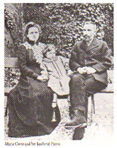
Marie and Pierre Curie with one of their daughters (Royal Institution)
|
|
|
|
|
|
|
|
|
|
|
|
|
|
|
|
|
|
 |
Marie and Pierre Curie with one of their daughters (Royal Institution) |
WHO WAS MARIE CURIE?
Marie Curie was the first woman to win the Nobel Prize and the only person to win the Nobel Prize twice. Working together, Marie and her husband Pierre, discovered the chemical elements radium and polonium.
Born on November 7 1867 in Warsaw, Marie Curie received her early scientific training from her father who was a physics teacher. She then went on to study at Cracow and 1891 she went to the Sorbonne in Paris obtaining her degree two years later.
To meet the expenses for fees, books and living Marie Curie had to work caring for the laboratories. While at the university she met Pierre Curie who was professor of physics and they eventually married in 1895.
WHAT DID MARIE CURIE ACHIEVE?
Marie Curie was interested in recent discoveries in the field of radiation and began studying uranium radiations. Using techniques devised by her husband she measured the radiations in pitchblende. Pitchblende is an ore containing uranium. Marie Curie identified there were radiations from the ore more radioactive than the ore itself.
She was the first scientist to use the term radioactive, to describe elements that give off radiations as their nuclei break down.
Pierre Curie joined his wife in her research and in 1898 they announced their discovery of polonium and radium.
In 1903 they were awarded the Nobel Prize in Physics for the discovery of radioactive elements. They shared this with another French scientist called Becquerel. Marie Curie became the first woman to win the Nobel Prize.
On 19 April 1906, Pierre Curie was killed by a horse drawn cart in Paris.
Marie Curie took over her husband's classes at the University of Paris and continued with his research.
She was again awarded the Nobel Prize in 1911, this time in chemistry, for her work in radium and radium compounds. This was an important achievement, as no one had ever been awarded a second Nobel Prize, made even more remarkable as women were not commonly involved in such work. Indeed, Marie Curie did not receive any recognition when in 1904 Pierre Curie was appointed professor of physics at the University of Paris nor in 1905 when he was made a member of the French Academy.
In 1914 Marie Curie was further recognised by being appointed head of the Paris Institute of Radium. She then went on to help found the Curie Institute.
Marie Curie died on 4 July 1934 of an illness directly caused by her excessive exposure to radiation over the years.
Even today, you will find the names Marie Curie and the Marie Curie Institute are still associated with cancer research and cancer care.